Tools and Strategies for Mobile Marketing Automation
Your app is fighting for attention even as the mobile market grows. The 2025 State of Mobile report shows consumer spending on apps hit a new high (about $150 billion), which means more users and more competition in the app stores. At the same time, app retention remains low, with only about a quarter of users returning on Day 1, and that percentage drops significantly in the following weeks.
That gap between growth and retention costs you both money and momentum. You may be paying more to acquire users while fewer stick around. Push and in-app messages can help, but performance varies by industry and campaign type, so poorly timed or generic messages can waste your budget and annoy users.
Mobile marketing automation gives you a way out. When you automate using real user signals, you send the right message at the right time and reduce manual work.
In this blog, you’ll explore the top tools for mobile marketing automation, key strategies for smart user engagement, and simple steps to set up and optimize automated campaigns for better results.
What is Mobile Marketing Automation?
Mobile marketing automation is software that helps you send the right message to the right user at the right time on their phone or tablet. It uses data from app or mobile web activity to build user profiles, trigger messages (push, in-app, SMS, email), and run workflows that scale personalized engagement.
Core Components:
Data collection and analysis: capturing behavioral, demographic, and device-level information.
User segmentation and cohort building: grouping audiences by actions, attributes, or lifecycle stage.
Campaign creation and automation: designing workflows based on triggers, timing, and rules.
Multi-channel delivery systems: connecting push, in-app, SMS, and email into one flow.
Performance tracking and optimization: measuring results and refining strategies through testing and analytics.
How It Differs From Traditional Marketing Automation
Traditional marketing automation often focuses on email sequences, lead scoring, and slower nurture cycles. Mobile marketing automation is built for real-time interaction, in-app engagement, and device-aware messaging. It also links directly with attribution systems to track installs, retention, and lifetime value metrics that are most important for mobile-first teams.
Key Benefits of Mobile Marketing Automation
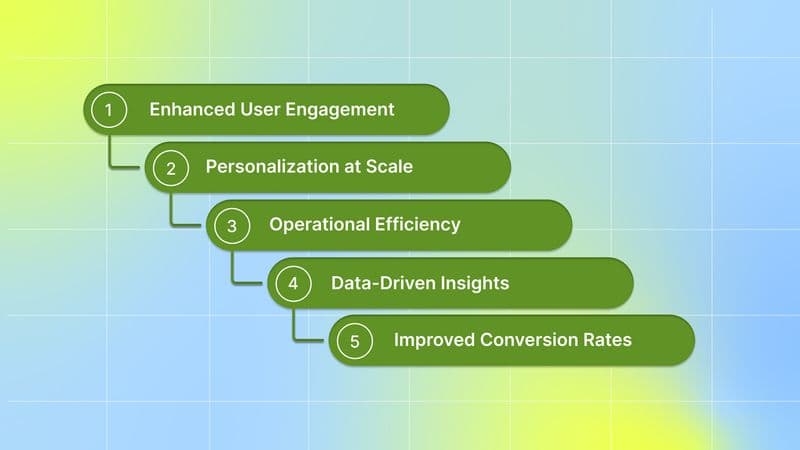
The following benefits explain why automation is essential for effective mobile strategies in 2025.
Enhanced User Engagement: Automated messaging, triggered by in-app events or specific user actions, increases engagement through timely and relevant interactions, leading to sustained engagement rather than sporadic spikes.
Personalization at Scale: Using user data and segmentation, automation enables tailored experiences, such as dynamic content and location-based offers, without requiring manual customization.
Operational Efficiency: By automating workflows and event-based triggers, teams reduce manual work, minimize errors, and can focus on strategy and creative tasks, improving both speed and consistency.
Data-Driven Insights: Automation platforms provide detailed analytics and AI-powered features, including predictive analytics and real-time decisioning, to forecast churn, identify high-value users, and optimize messaging for improved results.
Improved Conversion Rates: Automated, personalized flows such as abandoned-cart recovery or reengagement series guide users to take action, recovering lost revenue and boosting overall conversions.
Together, these advantages help mobile marketing teams build stronger customer connections, improve campaign performance, and operate more efficiently, turning automation into a critical tool for sustained growth.
Of course, the benefits only happen if you’re using the right tools. Let’s go through some popular platforms that can help.
Essential Tools for Mobile Marketing Automation
For mobile marketing teams, picking the right tools matters. Below are five platforms with clear, up-to-date notes on what each does, the main features you’ll use, and how each helps automate mobile campaigns in 2025.
1. Segwise
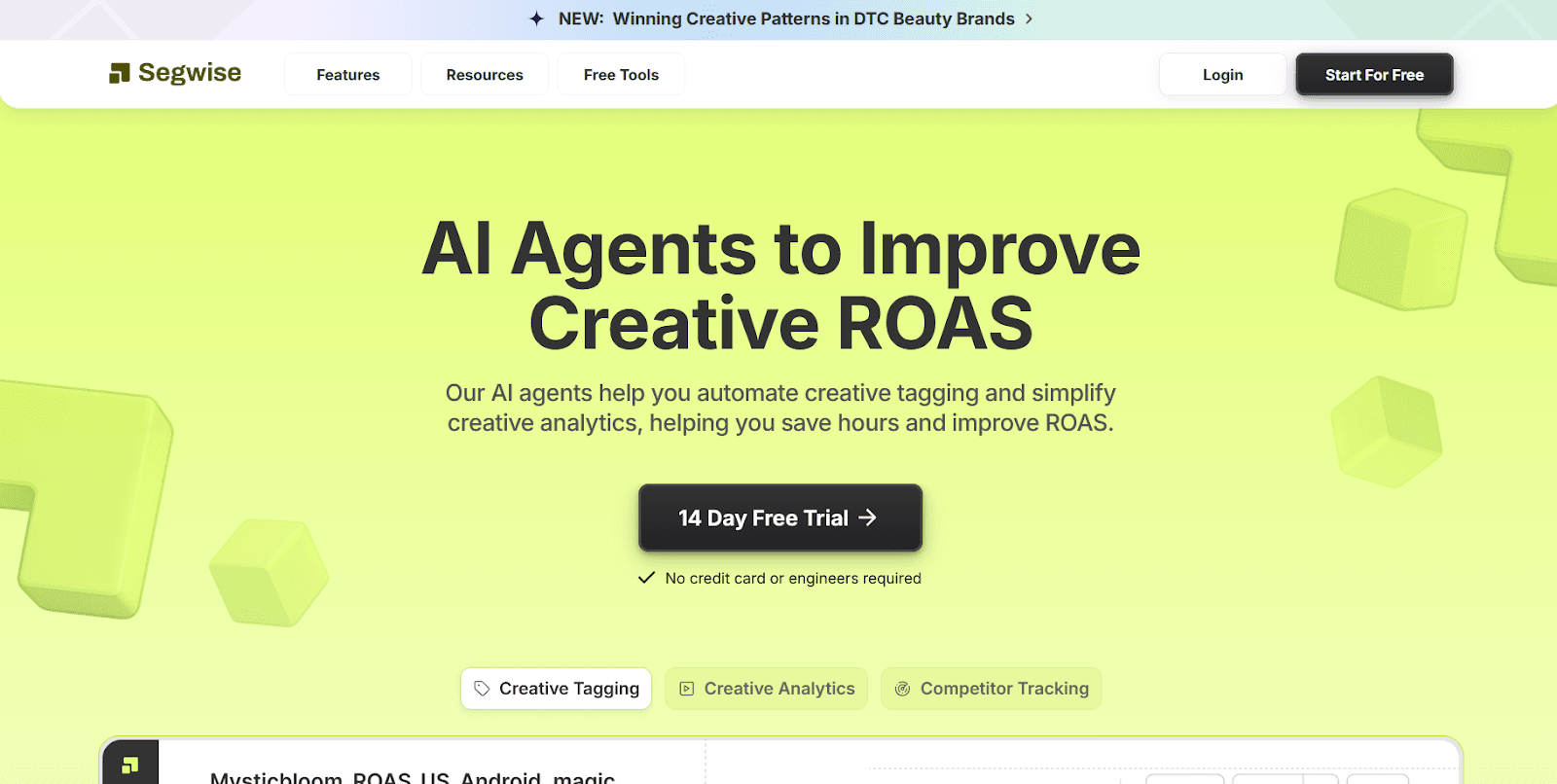
Segwise is a creative analytics platform that analyzes ad creatives at the asset level using AI. It automatically tags visual and textual elements, links those creative signals to performance, and highlights creative problems fast. You can use Segwise to prioritize which assets to refresh or swap in automated campaign rules.
Key features:
AI-powered creative tagging that automatically labels image and video elements, such as hooks, characters, colors, audio, and on-screen text.
Creative-level performance insights and anomaly detection (flags low-performing assets).
Privacy-aware app analytics and guidance for SKAdNetwork-era metrics.
How does this help your automation?
Segwise provides tag-level signals, alerts, and reports that marketing teams can export or integrate with their automation tools, allowing ad swaps, budget shifts, or A/B tests to be driven by creative health in addition to top-line metrics. Implementation requires wiring Segwise outputs into your campaign platform or automation layer.
2. Klaviyo
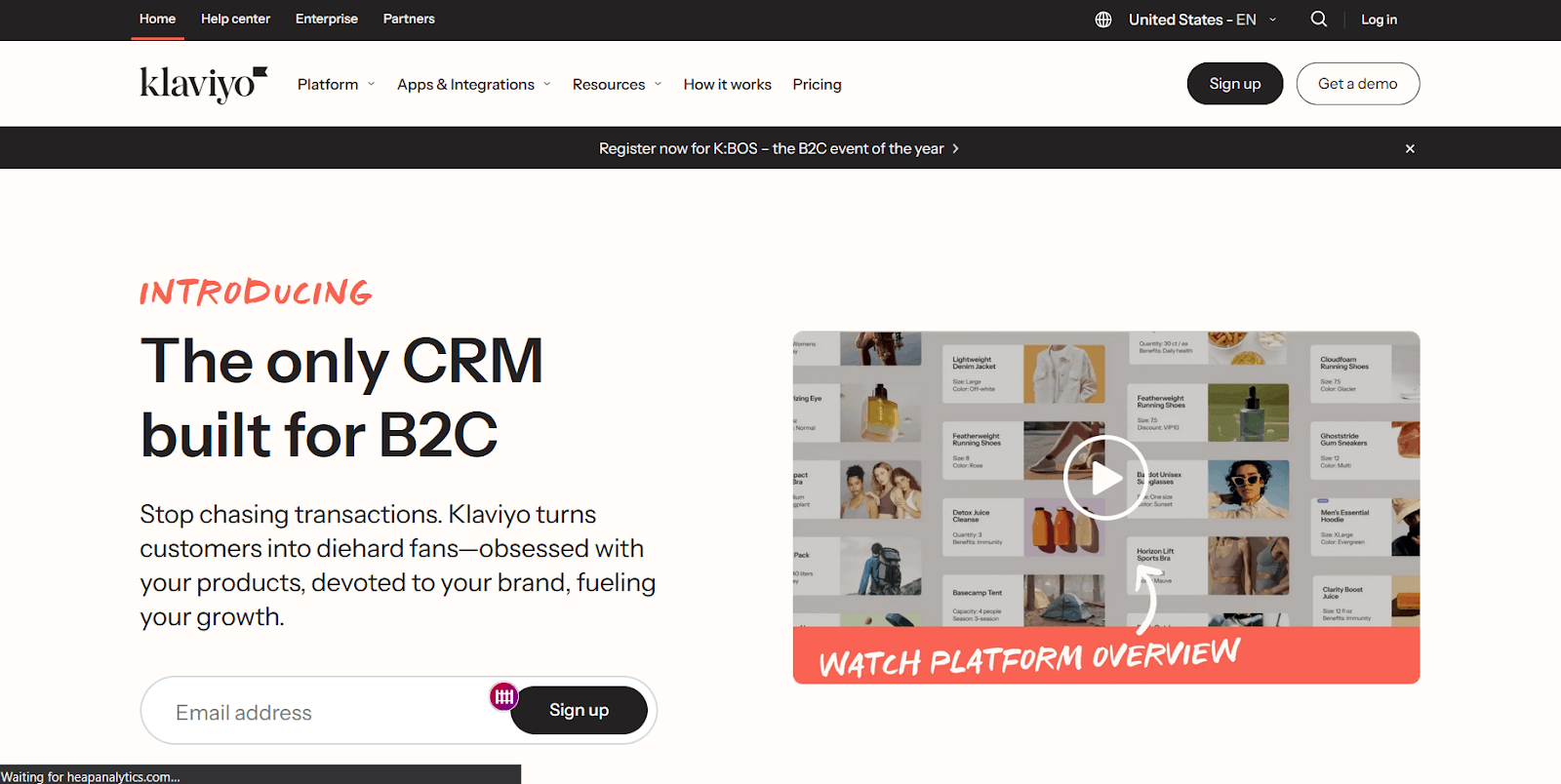
Klaviyo is a B2C marketing platform built around email and SMS with an embedded customer data layer. It stores profiles and event timelines, enabling you to create personalized flows that span email, SMS, and push. You can use Klaviyo to run cart recovery, welcome sequences, and segmented campaigns based on product and purchase data.
Key features:
SMS & MMS campaigns with personalization tokens and media support.
Mobile push and in-app messaging for behavior-triggered contact.
Drag-and-drop flow builder and segment builder for lifecycle automation.
Embedded CDP (profiles, event timelines) to unify mobile and web signals.
How does this help your automation?
Klaviyo centralizes user profiles and event data, allowing your push, in-app, and SMS flows to use the same audience rules and triggers. That lowers friction when you move a user through onboarding, winback, or lifecycle flows and want channel-specific actions to run automatically.
3. Braze
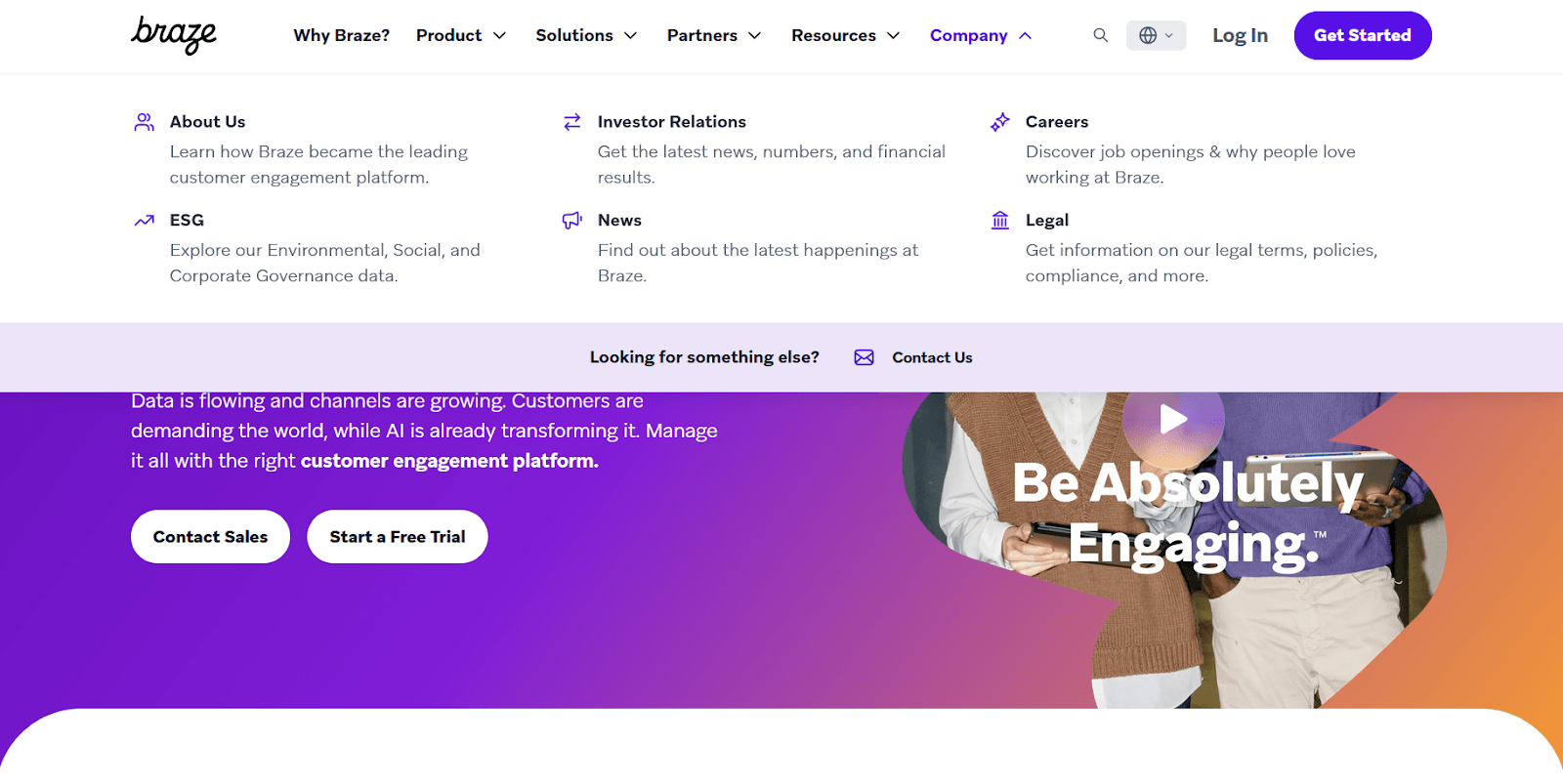
Braze is a customer engagement platform focused on mobile and cross-channel messaging. It provides a visual journey builder and advanced personalization tools so you can craft multi-step campaigns with conditional logic. You can use Braze to map and automate complex user journeys across push, in-app, and SMS.
Key features:
Canvas (visual journey builder) for multi-step, multi-channel journeys.
New personalization tools (Canvas Context, RCS support, in-app banners).
Landing page templates and campaign editors for quick campaign creation.
How does this help your automation?
Braze makes it easier to build end-to-end journeys that react to app behavior and external signals. Use Canvas to automate decision branches, channel fallbacks, and timed follow-ups, ensuring messaging consistency across push, in-app, and SMS without manual orchestration.
4. Gumloop
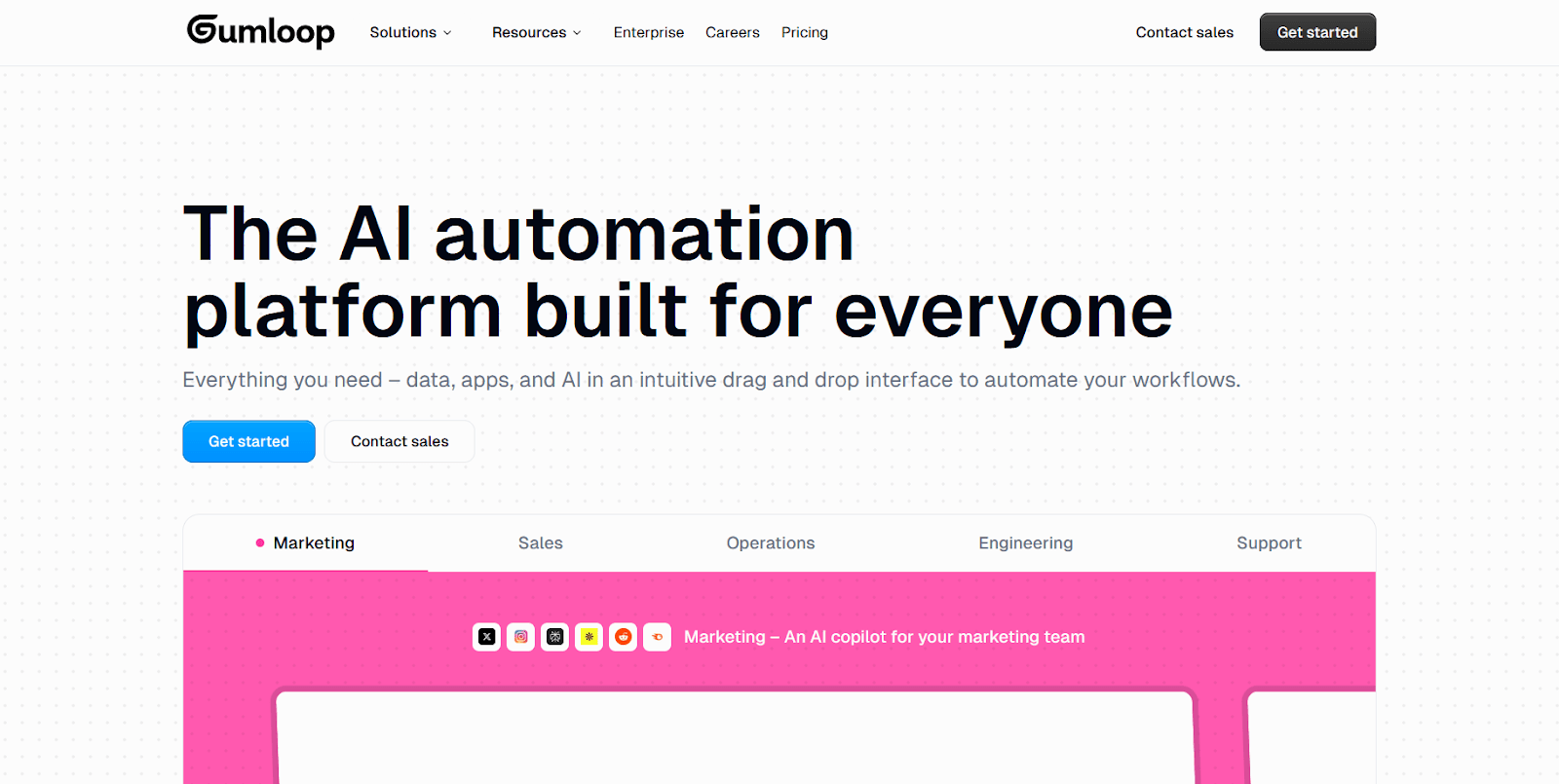
Gumloop is an AI-first workflow automation tool that combines a visual flow builder with AI nodes. It helps non-engineers create end-to-end automations that generate content, move data between systems, and trigger actions. You can use Gumloop to automate campaign creation, reporting, and routine optimization steps.
Key features:
Drag-and-drop flow builder (visual nodes and connectors).
AI agents and copilots for automating content, routing, reporting, and decision steps.
Wide integrations (CRMs, ad platforms, analytics, messaging providers) to pass data between systems.
How does this help your automation?
Gumloop can stitch together data, creative steps, and messaging actions into end-to-end automations. For mobile marketing teams, this means you can automate tasks such as generating message variants with AI, pushing variants to a campaign tool, reading performance data back, and then triggering re-allocations or creative refresh flows; all without heavy engineering.
5. CleverTap
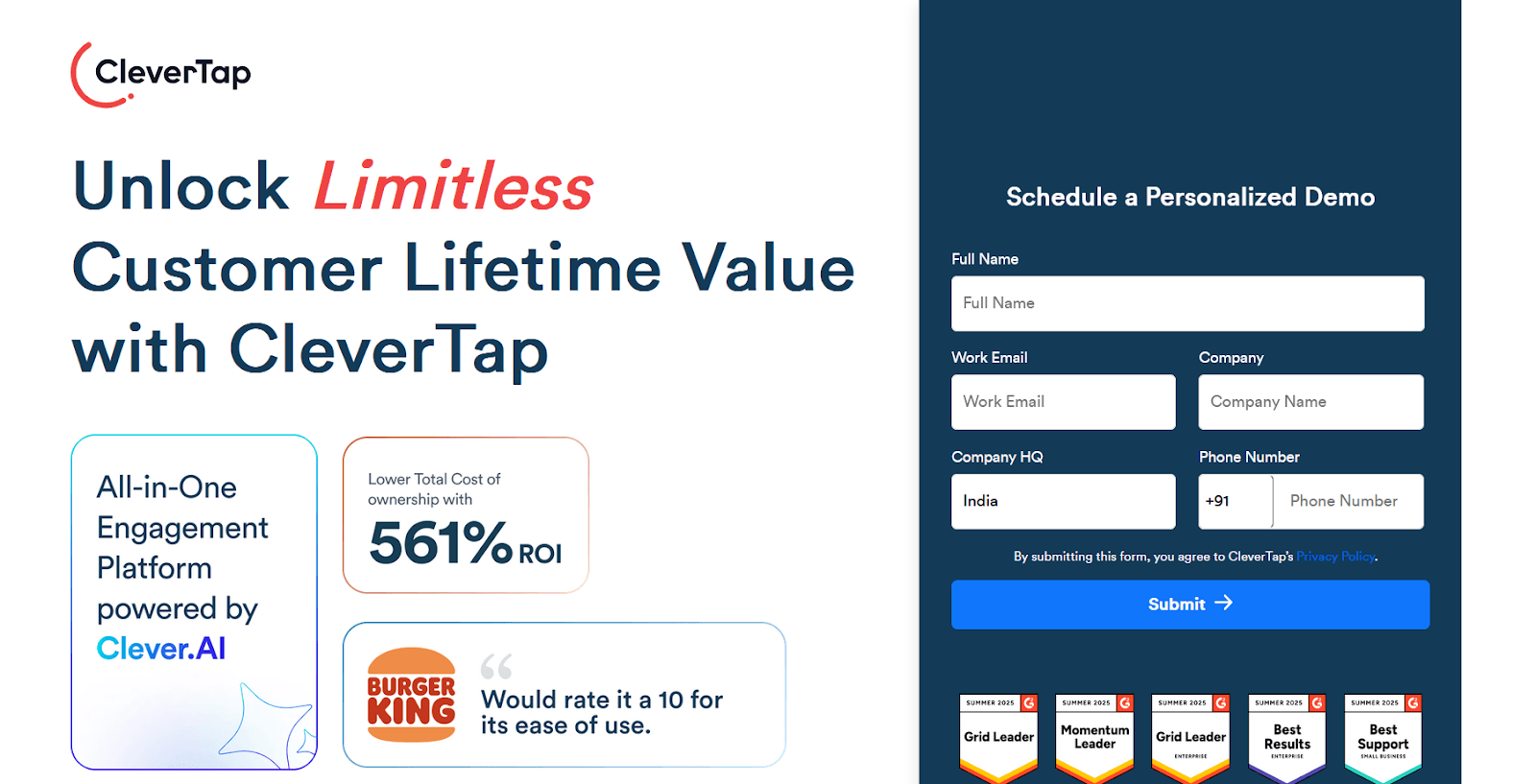
CleverTap is a mobile-first analytics and engagement platform that combines event-level analytics, segmentation, and campaign automation. It captures detailed user actions and builds behavior-based cohorts you can act on. You can use CleverTap to run retention programs, automate personalized offers, and measure lifetime value.
Key features:
Event analytics and behavioral segmentation to build cohorts from app actions.
Automated campaigns across push, in-app, email, and SMS with A/B testing and funnels.
Decisioning engine and AI capabilities for real-time action selection and personalization.
How does this help your automation?
CleverTap combines deep user signals with campaign decision logic so automated flows can pick the right message, timing, and channel for each user. That makes it easier to run continuous retention experiments and let the platform act on the best variant for each audience segment.
Match tools to your automation needs. Segwise offers creative signals for ad optimization. Klaviyo and Braze are ideal for unified lifecycle flows with email, SMS, and push. Gumloop supports cross-system AI workflows. CleverTap provides mobile analytics and campaign decisioning. Choose tools that match your automation goals and run tests to learn from results.
Having the tools is one side of the equation. You also need a clear strategy to get the most out of them.
Also Read: Top Creative Optimization Tools You Need in 2025
Strategic Approaches to Mobile Marketing Automation
To make mobile marketing automation work at scale, you need clear strategies that guide how you segment users, personalize experiences, and connect across channels. Here’s a breakdown of the most effective approaches for 2025.
1. Segmentation Strategies
Behavioral segmentation
Group users by their app usage patterns, including session frequency, session length, key in-app actions, and feature use.
Use purchase and transaction history to separate one-time buyers from repeat buyers.
Create segments for new vs. power users so messaging matches real behavior (for example, send tips to new users and advanced hacks to frequent users).
Demographic & geographic segmentation
Use age, gender, and income brackets where they are allowed and helpful for campaign goals.
Send location-aware messages when relevant (local offers, store events, or region-specific launches).
Segment by device type and OS to avoid sending messages that won’t work on a user’s device. Also consider the time zone and language when scheduling messages.
Lifecycle stage segmentation
Onboard new users with a focused welcome flow that teaches core values within the first sessions.
Run engagement flows for active users that surface features they haven’t tried.
Use re-engagement sequences for dormant users and win-back offers for churned users to recover lost value.
2. Personalization Strategies
Dynamic content delivery
Update message content in real time based on recent actions (cart items, last viewed content, in-app milestones).
Offer product recommendations powered by simple machine learning or rules that use past purchases and behavior.
Use contextual signals (recent action, location, device) to decide which creative or CTA to show.
Journey-based personalization
Create distinct onboarding paths tailored to different user goals (e.g., casual users vs. subscriber prospects).
Show feature discovery steps that match each user’s pace and history.
Let the campaign sequence adapt: if a user engages, move them to an upsell path; if they ignore messages, try a different channel or tone.
3. Cross-Channel Integration Strategies
Omnichannel campaign orchestration
Coordinate push, in-app, SMS, and email to ensure messages feel consistent and are not repeated too often.
Respect user channel preference: let frequent email openers get more email and heavy app users get more in-app messaging.
Maintain a single customer profile to ensure all channels utilize the same user data and history.
Attribution and measurement
Use cross-channel attribution models and customer journey analytics to see which touchpoints move users forward.
Track multi-touch impact to determine which sequence or channel mix yields the best return on ad spend.
Test and compare attribution windows and rules to match the app’s buying cycle.
4. AI and Machine Learning Integration
Predictive analytics
Train simple churn models to flag users who need re-engagement before they leave.
Forecast lifetime value to focus spending on users likely to bring the most revenue.
Use send-time prediction to pick when a user is most likely to open a message.
Real-time decision-making
Let models pick which creative or offer to show in the moment based on recent context.
Automate budget or bid changes for paid channels when a high-value segment is identified.
Combine rule logic with ML suggestions to keep your team in control as you scale decisions.
5. Privacy-First Automation Strategies
Consent management
Collect data with clear, simple consent flows and let users manage preferences easily.
Keep data collection transparent: explain what each choice enables and how it benefits the user.
Build campaign logic that respects consent choices automatically.
First-party data use
Prioritize first- and zero-party data (what users share directly) and use progressive profiling to gather what you need over time.
Offer a clear exchange of value: explain why sharing a preference or email will improve the user’s app experience.
Store and use first-party data to power personalization and measurement while limiting reliance on third-party identifiers.
Use these approaches to set clear goals, pick tools that match your stack, and run small tests to learn fast. Keep the user experience central, respect privacy choices, and let data guide which strategies you scale next.
Once your strategy is in place, the real challenge is putting it into action. That’s where best practices come in.
Also Read: How to Use AI for Marketing Optimization Success
Implementation Best Practices
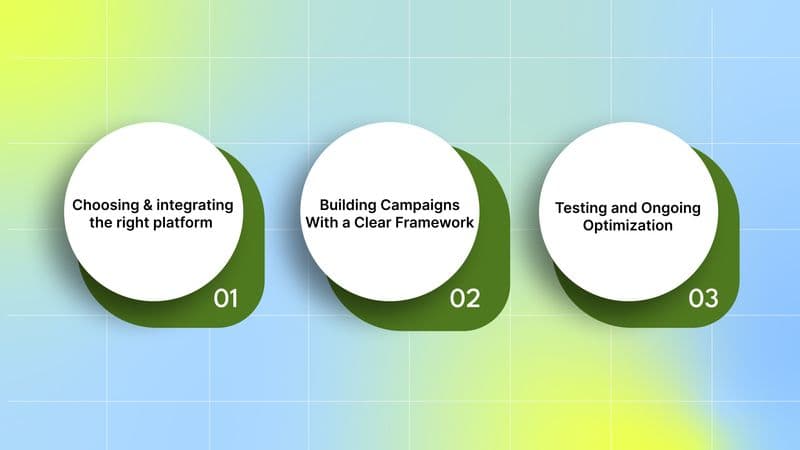
When you put mobile marketing automation in place, the way you set up the platform, plan campaigns, and keep testing makes all the difference. Here’s a practical guide you can follow.
1. Choosing and integrating the right platform
The first step is picking a system that works for your goals. Look for platforms that can handle real-time data triggers, advanced segmentation, multi-channel campaigns, and built-in testing features. Make sure it integrates smoothly with your current stack, whether that’s your analytics, CRM, or attribution tools. Check for strong API support and confirm the platform can scale as your user base grows.
Once you’ve chosen, plan the rollout carefully:
Map how data will move between tools to avoid gaps or duplication.
Set up and test API connections early.
Define team roles so it’s clear who manages events, who builds segments, and who approves campaigns.
Roll out in phases. Begin with high-value flows, such as onboarding or cart recovery, measure the results, and then expand step by step.
2. Building Campaigns With a Clear Framework
Strong campaigns begin with clear goals. Pick one main goal for each flow, such as reducing churn or encouraging repeat purchases, and connect every message to that outcome. Set measurable KPIs, define baselines and targets, and create a timeline with milestones.
Content and creative choices are just as important. Personalize messages based on user behavior or lifecycle stage, and keep design mobile-first with lightweight visuals, short flows, and clear CTAs. Stick to your brand voice across all channels.
To improve what works, incorporate A/B testing into campaigns, trying out different subject lines, timing, or offers, so data consistently supports your strategy.
3. Testing and Ongoing Optimization
Automation isn’t “set it and forget it.” Keep a testing rhythm in place. Use A/B tests for simple changes and multivariate testing for bigger combinations, and follow clear rules for sample sizes and statistical confidence before deciding winners. Maintain a testing calendar to help your team focus on the most impactful ideas, rather than random experiments.
At the same time, monitor performance in real time. Connect your platform to dashboards that track opens, clicks, conversions, and retention metrics. Set alerts for sudden drops or delivery issues so you can react fast.
Then, run regular review sessions weekly or biweekly to refine weak flows, scale strong ones, and record what you’ve learned for future campaigns.
If you select the right platform, start with structured campaigns, and keep testing and reviewing, your mobile marketing automation will keep improving instead of stalling.
Also Read: Why Creative Tagging Matters for Mobile Game Marketers in 2025
Conclusion
Smart mobile marketing automation works when it acts on the right signals, not just top-line metrics. The real win is combining real-time data, clear segmentation, and automated workflows that adjust messaging based on what users actually do. When teams focus on meaningful triggers and keep testing, they improve engagement, conversions, and retention without extra manual work.
Segwise helps by turning creative performance into clear, actionable signals that plug directly into your automation. Start a 14-day free trial with Segwise to see how fast data-backed creative decisions can boost your campaigns.
FAQs
1. What automated flows should I build first for the biggest impact?
Begin with onboarding and a win-back (reengagement) flow, as they typically improve Day-1 retention and quickly recover lost users.
2. Which channels pay off most for mobile automation?
Prioritize push notifications, in-app messages, and SMS for direct app engagement, then add email and ads as your profile data and consent permit.
3. How do I measure whether automation is working?
Track retention, conversion rates, and LTV alongside attribution windows so you can link automated flows to installs, purchases, or repeat use.
4. How do I keep automation privacy-friendly?
Collect clear consent, use first-party data and a consent SDK, and build flows that automatically respect user choices.
5. Can AI help decide who to message and when?
Yes, simple churn or send-time models can flag at-risk users and suggest the best message or timing to reengage them.

Comments
Your comment has been submitted successfully!